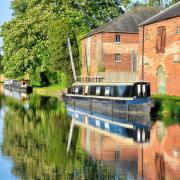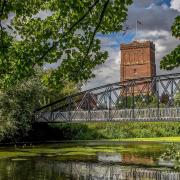Steve Roberts takes a trip down memory lane and explores parts of our county's historic rail network and finds a much-altered landscape
Derbyshire has seen its fair share of branch line closures over the decades, with the railway enthusiast’s bogeyman, Dr. Beeching, playing his customary role.
Quaint little communities lost their station and connection to the world. Sometimes the whole branch closed: Even when a line survived, intermediate stops disappeared.
Occasionally, a station has been re-born, with trains once more sidling into its platforms. In most places though, it’s ghost trains you’ll be listening out for – here are a few of them which have fallen by the wayside.
Manchester, Buxton, Matlock and Midland Junction Railway
What became part of the Midland Railway’s mainline betwixt London and Manchester has experienced a variety of fates.
The Derby-Matlock section still has passenger services, whilst the next block of four miles (Matlock-Rowsley) is today the Peak Rail Heritage Line, whilst the Rowsley-Buxton now provides recreation in the guise of the nine-mile Monsal Trail.
The first part of this cross-country line opened in 1849, as far as Rowsley, although completion of the other sections through to Manchester was not finally achieved until 1867.

A century later, the line beyond Matlock was closed and, with track lifted beyond Rowsley and the Monsal Trail doing a steady trade in walkers and cyclists, that appeared to be that.
There have been periodic plans for reopening to Buxton though, so this story may have mileage left in it yet.
The Ashbourne Line
The 33½ mile line from Buxton to Uttoxeter via Ashbourne was built by the London and North Western Railway (L&NWR) which already had its station in Buxton facing t’other way for Manchester.
The Midland Railway (the line to Derby above) also had its station in Buxton, right alongside the L&NWR one.
Buxton was clearly a busy place back in the day. The first stop out of Buxton on the new Ashbourne Line was Higher Buxton, which opened in June 1894.
A couple of stops before Ashbourne was Tissington (1899), a clue if one were needed that we’re talking Tissington Trail here.

Beyond Ashbourne was Clifton (Mayfield) station, which dated to May 1852. All three stations would close in the early 1950s - Higher Buxton first in April 1951, with the other two following when the line closed to passengers in November 1954.
However, freight continued to rumble along the route for another decade or so, and still does on the northern section (Buxton to Hindlow/Dowlow). The 13-mile Tissington Trail, a cycle and walking route, was one of the first such enterprises in the whole country.
Cromford and High Peak Railway
The C&HPR was built ostensibly as a freight line, joining the Cromford Canal Wharf (High Peak Junction) and the Peak Forest Canal (Whaley Bridge).
Its raison d'être was transporting goods and minerals across Derbyshire’s Peak District. Opened as early as 1831, the line would continue right up until 1967.

The junction at the Cromford end was with the Midland Railway line (that Manchester, Matlock, Buxton and Midland Junction Railway).
Heading towards Buxton, the line joined with the L&NWR line (the Ashbourne Line) before skirting Buxton on its way up to Whaley Bridge.
The part of the line between Dowlow (near Buxton) and High Peak Junction became the High Peak Trail.
The route had been marked by a number of roped worked inclines and the Middleton Incline Engine House (near the Cromford end of the line) is preserved with the old static beam engine that once hauled loaded wagons up and down the Middleton Incline, with its 1-in-8 gradient being demonstrated.
The Steeple Grange Railway, meanwhile, is a narrow gauge railway which utilises the track bed of a former branch off the C&HPR.

The Derbyshire and Staffordshire Extension
An extension of the Great Northern Railway (GNR), the 1870s Derbyshire and Staffordshire Extension was the GNR’s attempt to get a share of the coal traffic in this part of the world with a two-pronged line merging on its approach to Derby, continuing on to Egginton Junction where it joined with the North Staffordshire Railway.
The line was run down in the 1960s, with the Nottingham-Derby passenger service going in 1964 and the Derbyshire Extension seeing its last commercial traffic in 1968.
Mickleover station, just a couple of stops from the junction at Egginton, was closed to passengers as long ago as October 1939, perhaps as a wartime economy measure, and it would never re-open, although it did retain goods facilities until 1964.
Egginton Junction, meanwhile, was closed in March 1962 but the stretch of line from Egginton, through Mickleover, back to Derby, was retained as a British Railways test track as BR had its Railway Technical Centre at Derby.
It was therefore on this stretch of line in Derbyshire that the much-maligned Advanced Passenger Train (APT), the ‘tilting train’, was put through its paces.
The Melbourne Line
Constructed between Derby and Ashby-de-la-Zouch (Leicestershire), the Melbourne Line has an interesting history.
Melbourne Station opened as a terminus in September 1868 for the line from Derby Midland station, becoming a through station in 1874 when the line was extended on to Ashby.
Melbourne lost its passenger service in 1930, however, with the military moving in when WWII began, the station becoming the Melbourne Military Railway Depot with the line used for the training of military railway personnel.
The line was not returned to the railway company, the LMS (London, Midland and Scottish Railway) until 1945, which itself would soon be superseded by BR.
The line continued on until 1980 when it was finally closed to freight traffic. The former trackbed is now used for the Cloud Trail, which combines with canal paths to provide a traffic-free route between Derby and Worthington.
Killamarsh

Killamarsh, a small town of fewer than 10,000 souls, nevertheless once had no fewer than three railway stations. Today it has none.
Working from west to east there was: the Midland Railway’s Killamarsh West; the Great Central Railway’s Killamarsh Central; and the Lancashire, Derbyshire and East Coast Railway’s Upperthorpe and Killamarsh.
It just goes to show what could happen back in the days when a plethora of railway companies were all intent on getting their piece of the action and sometimes all arrived in the same place.
The West station was the first arrival in 1841 but lasted less than two years because of financial difficulty.
A new station opened in 1873 and would close in 1954. Killamarsh Central opened in towards the turn of the 20th century, in 1892, closing in 1963. The last – and most short-lived - to open was Upperthorpe and Killamarsh in 1898, which also became the first to close in 1930.
The fates of the three lost lines have varied, a seeming microcosm of the Derbyshire ghost trains story.
The old LD&ECR route remains derelict as though it was only recently abandoned. The old Midland Railway line through what was the West station is still open for freight traffic, which offers the tantalising prospect of a station reopening in Killamarsh in the future.
The line that once headed through Central is today part of the Trans Pennine Trail, yet another footpath, but a long-distance one in this case.



























